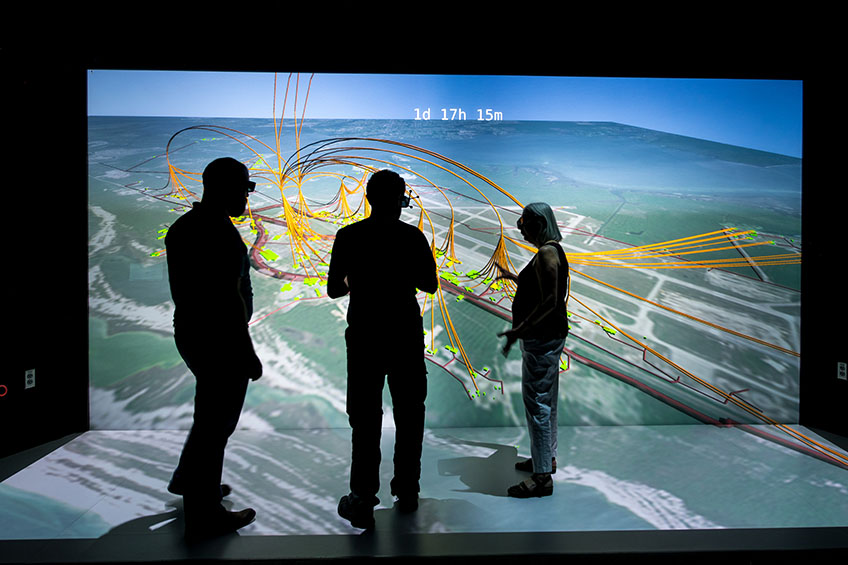NREL, U.S. Air Force Collaborate on Growing Portfolio of Resiliency Work

As the U.S. Air Force (AF) continues to bolster its resilience efforts, the National
Renewable Energy Laboratory (NREL) continues to grow its capabilities and expertise
in this same area. NREL’s partnership with the AF has led to smarter, stronger, and
more flexible base infrastructure, strengthening the AF’s ability to execute its missions
worldwide.
In 2018, a team from NREL worked with AF to identify vulnerabilities at Florida’s
coastal-located Tyndall Air Force Base and put together a risk mitigation strategy.
NREL brought its 40-plus years of renewable energy expertise to the table and presented
the AF with options, featuring a strategy that included the supplementation of traditional
energy sources with renewable sources in a variety of ways. The strategy was designed
to boost resiliency, but it also uncovered a critical need to consider the interdependency
of the energy system and other systems, such as communications, transportation, food,
and water. It effectively places a greater importance on the surrounding community,
where many of the base personnel have a vested interest.
“Right after we did that assessment, Tyndall was hit with a Category 5 hurricane,"
said Sherry Stout, NREL engineer. “We were able to validate how close we were. After a hurricane is
a vulnerable time to go into any community of people. To have that level of trust
in us; to be able to sit down and talk about the base and some of their homes—that collaboration taught us a lot about which stakeholders to engage and how to engage
them. Tyndall was so collaborative and helped us work through the process.”
Hurricane Michael ripped through the Southeast, leaving a torn-up Tyndall Air Force
Base in its path, before the AF could implement any of the mitigation strategies.
While Tyndall considered the mitigation strategies provided by NREL for its ongoing
rebuilding effort, the AF continued to focus on strengthening the community. As a
result, the U.S. Department of Defense (DoD) recognized a growing need to address
severe weather and its potential impact on national security.
Mark Jacobson, NREL senior project leader and liaison to the AF, said the relationship
between NREL and the AF is growing. Jacobson said he sees NREL as more of a strategic
partner to the AF in matters of increasing resiliency—microgrids being one area of
specific interest across all of DoD.
“We’ve supported a number of bases in the preliminary design and/or evaluation of
microgrids, and that number is increasing because of the positive feedback we’ve received
from previous projects,” Jacobson said. “We can combine that engineering analysis
with providing actual testing facilities where we can test hardware-in-the-loop. Microgrids
are becoming ever so important as a solution to resiliency at individual bases, and
we have our own microgrid at our Flatirons campus. We’re not just running a computer
model. We actually have physical equipment that can be tested to replicate real work
problems on the base. That’s just the kind of support the Air Force is looking for.”
NREL and the AF have been partnering on energy projects for many decades. In the past,
these collaborations have been on more of a project-by-project basis, but certain
requirements have pushed NREL into an integral position to the planning stages, as
well as execution. One driver, set forth by the Office of the Secretary of Defense,
is a requirement for each base to develop an installation energy plan.
“They look at the installations from a high-level perspective and understand the missions
the base has and make sure the energy plans support the missions,” Jacobson said.
“We are starting to provide support for some of the projects resulting from these
plans and are looking to increase that level as needed.”
NREL is uniquely positioned to provide the kind of support the AF prefers.
“We’ve got a reputation of being an honest broker and providing independent analysis
that isn’t pushing one technology or another or one brand or another,” Jacobson said.
“We can combine our engineering analysis with actual testing facilities. Marry these
strengths to our high-performance computing facilities and dozens of specialty energy
labs that make up the Energy Systems Integration Facility, and it gives NREL a unique
set of capabilities to offer not only the Air Force, but all of DoD.”
NREL has nearly 900 active partnership agreements spanning industry; academia; and
federal, state, and local governments. NREL can draw on those partnerships as required
to pull in even more expertise and address even the most challenging specific requirements
the AF can present.
“We have great relationships with the private sector, collaborating on near-term problem
solving,” Jacobson said.” We may propose certain ideas and outline a particular spec
or high-level overview of a design solution, but the final specs and design are determined
by iterating with the private sector and listening to their real world operational
and maintenance concerns. We have a lot of relationships with manufacturers, and there
is a host of examples where we worked with the top manufacturers and engineering firms
across the country to collaborate on a final implementable design solution.”
For example, one long-time partner of NREL, Eaton Corporation, has taken the lead
on a project at Tyndall and named NREL a partner. Eaton Corporation has a couple dozen
employees embedded in NREL through a colocation arrangement to develop innovative energy solutions.
NREL’s commitment to partnering with the right people in the right places at the right
times; its innovative technology testing facilities; and its wide swath of industry-leading
experts on a variety of energy systems of past, present, and future make the national
laboratory an especially attractive option for delivering data-driven solutions to
meet DoD’s energy resilience needs.
Read the Tyndall Air Force Base project case study.

